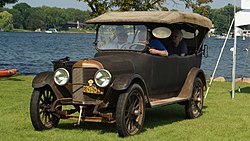Oakland Motor Car Company
Parent General Motors | | |
The Oakland Motor Car Company of Pontiac, Michigan, was an American automobile manufacturer and division of General Motors. Purchased by General Motors in 1909, the company continued to produce modestly priced automobiles until 1931 when the brand was dropped in favor of the division's Pontiac make.[1]
Beginning
The company was created by Edward Murphy who owned the Pontiac Buggy Company and Alanson Brush who was working as a consultant in Detroit after leaving the Cadillac Motor Company. Oakland Motor Company was named for
GM Division
After one year of production, Oakland's principal founder, Edward Murphy, sold half of the company to
Oakland Six and V8
In 1913 the Oakland Six was introduced followed in 1916 by the Model 50 365 cu in (6.0 L) flathead V8 engine sourced from Northway Motor and Manufacturing company,[4][5] and production soared to 35,000 in 1917.[2] The Series 50 V8 used a flathead design shared with the Oldsmobile Light Eight and the Cadillac Type 51.[6] The Model 50 was only available from 1915 to 1917 as a seven-passenger touring sedan on a 127" wheelbase and was listed at US$1,600 ($44,800 in 2023 dollars [7]).[1]
In 1930, Oakland reintroduced the Model 101 V8, again using a flathead architecture, on a 117" wheelbase and offered it as a roadster, phaeton, coupe, closed body sedan and sport coupe. Prices were listed at US$895 ($16,324 in 2023 dollars
Pontiac joins Oakland then replaces Oakland
As General Motors entered the 1920s, the product ladder started with the price-leading Chevrolet marque, and then progressed upward in price, power, and luxury to Oakland, Oldsmobile, Buick, and ultimately Cadillac. By the mid-1920s, a sizable price gap existed between Chevrolet and Oakland, as well as a wide gap between Oldsmobile and Buick. Also, a product gap existed between Buick and Cadillac. General Motors pioneered the idea that consumers would aspire to buy up an automotive product ladder if a company met certain price points-called the
Oakland's part in this plan was the 1926
-
1909 Oakland Model 40
-
1914 Oakland Model 36 Touring
-
1916 Oakland Model 50 V8
-
1931 Oakland V8
-
The Oakland Tree in Virginia City, Nevada
References
- ^ OCLC 34905743.
- ^ ISBN 0-525-097929.
- ^ a b c d e "Oakland History". Oakland-Pontiac Worldwide. Retrieved 19 December 2014.
- ^ Clymer, Floyd. Treasury of Early American Automobiles, 1877-1925 (New York: Bonanza Books, 1950), p.166.
- ^ "Rare Oakland Vehicles on display at AACA Museum". Old Cars. Active Interest Media All Rights Reserved. 30 September 2019. Retrieved 6 April 2021.
- ^ "Northway Engine Works". Antique Automobile Club. Antique Automobile Club of America. 6 November 2002. Retrieved 6 April 2021.
- ^ a b c 1634–1699: McCusker, J. J. (1997). How Much Is That in Real Money? A Historical Price Index for Use as a Deflator of Money Values in the Economy of the United States: Addenda et Corrigenda (PDF). American Antiquarian Society. 1700–1799: McCusker, J. J. (1992). How Much Is That in Real Money? A Historical Price Index for Use as a Deflator of Money Values in the Economy of the United States (PDF). American Antiquarian Society. 1800–present: Federal Reserve Bank of Minneapolis. "Consumer Price Index (estimate) 1800–". Retrieved February 29, 2024.







